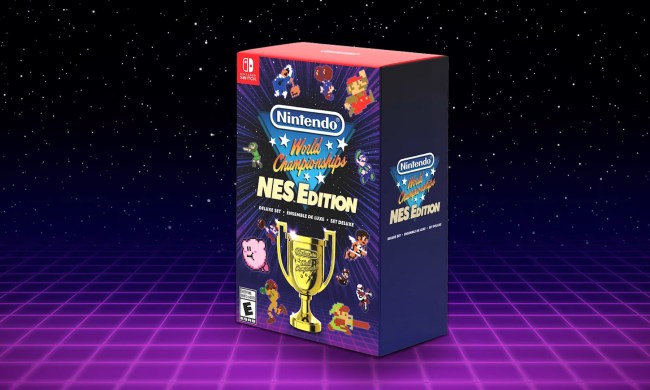- Smashing terrain is endlessly satisfying
- Subverts traditional 3D platforming thinking
- Simple but touching story
- Begins to feel formulaic near the end
- Some transformations and skills feel superfluous
Right from the title screen, Donkey Kong Bananza made it clear it wasn’t going to play by normal 3D platformer rules. I’m not greeted with a traditional menu, but a rock wall and a single button prompting me to smash through. Bananza constantly rewarded me for keeping that mentality in mind and refusing to play by the rules.
Rather than the tried-and-true Mario 3D platformer we all expected to release during the Switch 2 launch window, Nintendo has decided to take a somewhat risky swing with Donkey Kong Bananza . This game has the bones of a modern 3D platformer collect-a-thon, but isn’t intent on living in the shadow of Mario. This is Donkey Kong finally getting a chance to break out of his shell and define a unique gameplay formula all his own. Of course, that comes in the form of the nearly unrestricted destruction Banaza encourages. In that sense, this game feels like an attempt to break down the traditions of the genre and build something new.
The result is an experience that takes a little while to find its footing, but once it finds its voice, doesn’t shy away from being different. When Bananza is willing to break out of its shell and explore what makes it unique, it is a shining example of why it is worth putting yourself out there. It doesn’t make a flawless first impression, but there’s a lot more to dig into than it first appears.
Break it down
The setup for Donkey Kong Bananza feels light even by 3D platforming standards. DK is a miner who loves bananas, and an evil corporation called VoidCo is stealing them all on their way to the planet’s core. Once you rescue Pauline, the mission changes to getting her to the core where it is said any wish can be granted.
As Pauline becomes more confident in her voice, so too does Bananza in its subversion of the 3D platformer.
It does the job of giving you a goal and some bosses to look forward to fighting, but not much motivation beyond that. The three new villains feel like cardboard cutouts until around halfway through the game, only there to put up roadblocks at the end of a level. The problem is that I didn’t know what their goal was for way too long, meaning I had no idea what was at stake. That’s an important piece of missing context when I am arguably doing more damage to each ecosystem than the supposed villains. It’s a small thing in a game more focused on the mechanics and relationship between DK and Pauline, but still felt oddly absent.

Pauline is the real heart and soul of Bananza . The trailers kept her a secret as the mysterious Odd Rock at first, but it isn’t long before she breaks free and lends her singing powers to DK. Breaking out of her rocky shell is just the beginning of Pauline’s arc, however. As much as she loves singing, she’s hesitant to do it in front of others. Her voice is the only way to activate DK’s new Bananza forms, forcing her to step out of her comfort zone to learn each new form. It’s a subtle bit of character growth, but representative of Bananza ‘s entire theme of breaking out of one’s shell. As Pauline becomes more confident in her voice, so too does Bananza in its subversion of the 3D platformer.
Dig a little deeper
Beyond being endlessly cathartic to rip through entire levels, the destructability in Donkey Kong Bananza requires a fundamental shift in level design. Granted, there are hard boundaries preventing you from completely flattening a level, and there are sections that strip back your terraforming powers, but it is done in service of pushing the player to think of new ways to use the mechanic rather than shying away from it. An early example is a metal revolving door I can’t normally break. I could just wait for it to turn and treat it like a normal platforming obstacle, or rip through the walls, floor, or ceiling to bypass it entirely. Even the throwback stages reward a fresh approach. I only realized by accident on my first 2D barrel stage that I should ignore my instincts and aim at the rock walls and not around them to blast through them. Those type of moments are what Bananza does best.
Donkey Kong Bananza requires a fundamental shift in level design
What is unfortunate is that it takes a little too long for Bananza to start giving me more of those tools to play with. The first several stages don’t introduce much in the way of creative twists on digging, smashing, and throwing rocks around. That’s just a small blip in the grand scheme of things, however, because Donkey Kong Bananza is a huge game. Every time I thought I was approaching the end, I was introduced to a new level, mechanic, and hundreds of collectibles. It borders on overstaying its welcome mechanically, but certainly does formulaically. Aside from a few exceptions, each level has the same core components of finding a record (usually broken into multiple pieces) to learn a new Bananza, breaking VoidCo machines that are harming the local area and preventing you from diving lower, and fighting a boss or two. These might be done in different orders, but the repetition wears thin.
Thankfully, Bananza isn’t a game you’re likely to rush through. Even when I was dead set on making progress through a level, a hidden banana, a challenge level, a treasure chest, or an environmental puzzle would draw me away. Donkey Kong 64 earned a reputation for having an overwhelming number of collectables, but Bananza blows that game out of the water. The difference here is that the number of collectible types and their uses are kept in check. Bananas are used to level up, fossils to buy outfits, and gold for items, and that’s mostly it. This is the most direct carryover from Odyssey , and is the aspect of Bananza that feels the most safe. Even the new abilities you can unlock by levelling up aren’t all that exciting; only a slim few give you new moves, while the rest are stat buffs.

The titular Banaza transformations feel slightly underutilized for how heavily they are featured, and some feel too specific to whip out in general gameplay. The gorilla transformation that powers up my punches is always useful, but the zebra that can run across specific terrain types never felt useful beyond the few times it was required. There are some challenge stages that focus on each of your Bananza forms that show their full potential, but you will need to seek them out to experience them.
Donkey Kong Bananza could’ve easily been a reskinned Mario game with Stars replaced with bananas, but Nintendo chose the riskier path. While it has the familiar structure of past 3D platformers, everything about how I engaged with Bananza felt like a deconstruction of the genre (pun intended). While it may stick a bit too close to a familiar core structure, Bananza goes deep in exploring clever and unique ways to use its destructive systems to build a confident new platformer.
Donkey Kong Bananza was tested on the Nintendo Switch 2.





